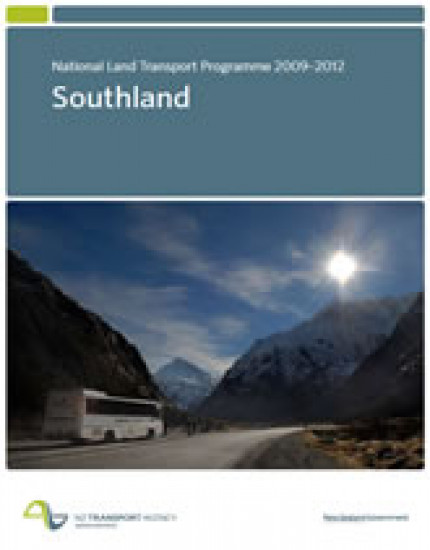The Southland region needs to address a number of transport-related issues between now and 2012. Our top priority in delivering economic growth and productivity in the region is to ensure freight can move within Southland efficiently and safely.


I am pleased to introduce to you this National Land Transport Programme (NLTP) for 2009-2012 – a programme through which the NZ Transport Agency (NZTA) is making a record investment in land transport at a time when New Zealand needs it most.
The global economic situation has changed dramatically in the past 18 months, with significant effects for the New Zealand economy. In response, and as part of its commitment to improving New Zealand's economic outlook and performance, the government has set clear expectations and priorities for the land transport sector. These expectations are articulated in the Government policy statement on land transport funding 2009/10 – 2018/19 (GPS)(external link).
Through the NLTP, the NZTA 'gives effect' to the GPS with a focus on supporting economic activity and employment throughout the country. It aims to deliver the best possible returns for New Zealand, through prioritising a wide range of national and regional activities and investing $8.7 billion in the next three years ( a 17 percent increase on the past three years).
The NLTP demonstrates an increased focus on efficiency and effectiveness in all spending, a rigorous national approach to setting priorities, and an ongoing focus on improving safety and reducing the adverse environmental effects of land transport.
While each region's regional land transport programme (RLTP) has been an essential building block, the NLTP inevitably makes greater investments in areas where key expectations, such as economic return and value for money, are clearly met.
This document details the funding provided for the Southland region – and as a dynamic document will be reviewed and updated regularly to reflect any approved variations to programmes.
For information on funding for the rest of New Zealand (and how the NLTP is developed and managed) please see the national NLTP document.
The Southland region needs to address a number of transport-related issues between now and 2012.
Our top priority in delivering economic growth and productivity in the region is to ensure freight can move within Southland efficiently and safely. Our plans include:
Road safety and the high social and economic costs of road crashes are other issues for Southland, with a number of projects in the NLTP dedicated to addressing them. Some projects, can also make highways more efficient through smoother traffic flows.
Additional transport priorities for Southland include:
A strong commitment to value for money has led to changes in how R (regionally distributed) funding is used. R funding will be used for the highest-priority projects in this NLTP, providing a guaranteed minimum level of funding for Southland. R funding comes from a portion of fuel excise duty and light road user charges and is allocated proportionally to regions based on population.
In the past, R funding was used to fund lower-priority projects that would otherwise not qualify for funding. The new approach delivers much greater value for money for all public money invested in land transport.
This NLTP provides an investment of $155.1 million for the Southland region over the 2009–2012 period. I'm confident that this NLTP gives the required effect to the GPS. All funds have been allocated to activity classes within the GPS limits and in line with the NZTA's priorities.
Key investment priorities for Southland:
For an overview of all projects in the region likely to receive funding in the next three years, see the regional map.

The National Land Transport Fund can only be used to fund activities listed in the NLTP. The tables in this NLTP list:
In the past 12 months, we've achieved a number of milestones in making our region's roads safer, more resilient and more suitable for the people and businesses that use them every day. These include:
The Southland Regional Transport Committee plays a pivotal role in shaping the Southland region's transport future.
The committee comprises elected members from the regional and local councils in Southland, a representative from the NZTA and six community representatives with expertise in areas such as access and mobility, safety and economic development.
One of the committee's key tasks is to develop Southland's three-year RLTP, which prioritises all the regional transport activities proposed by the NZTA, the region's local authorities and Environment Southland.
This regional perspective enabled the NZTA to build a geographic view of land transport requirements nationwide, and to align regional and national views in deciding on the most appropriate allocations of funds to give effect to the GPS priorities. Public submissions on Southland's draft programme were reflected in the final programme that went to the NZTA Board, which made the ultimate funding decisions for the NLTP.
I believe this NLTP is enabling for Southland's future as a key contributor to New Zealand's social and economic wellbeing. I look forward to working closely with our regional and local authority partners, New Zealand Police and the Southland community on ensuring this NLTP is implemented successfully.
Bruce Richards
Regional Director
Last updated: 6 October 2009